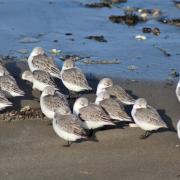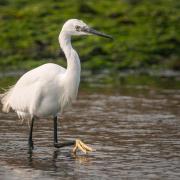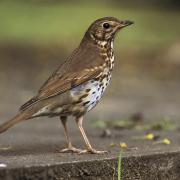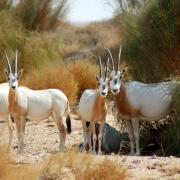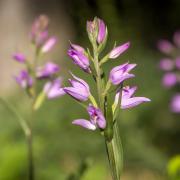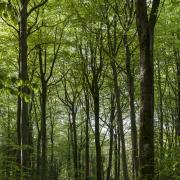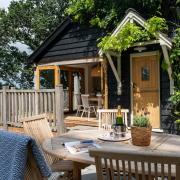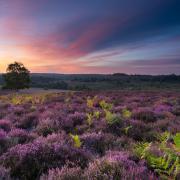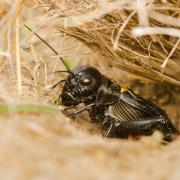With spring in the air, Natalie French visits the New Forest to meet one of the rarest breeds of sheep and discovers why the imported Valais Blacknose now living there have earned a reputation for being very cute
If you’re in the New Forest, keep your eye out for a flock of cute creatures grazing on the grass. You’ll know you’re close when you hear the gentle tinkling sound of the Swiss copper bell – before a sea of inquisitive black noses, matching black knee-pads and curly white fringes will greet you – and most likely steal your heart.
Since the reintroduction of the wolf in Switzerland, the endangered Valais Blacknose breed has dwindled to just 12,000 registered in their native country. Around 500 are here in the UK, since the first imports in 2014 and the first flock of these rare sheep arrived in the New Forest in 2016 and are owned by two animal-loving friends, Abby Bolt and Emma Childs from Fordingbridge.
“We first saw Valais Blacknose sheep on BBC’s Countryfile back in 2012, before the breed existed here in the UK,” explains Abby. “When they arrived on British shores two years later, they caused quite a stir. If you see one, you will understand why - they are striking sheep! They have a wonderfully docile temperament, are naturally friendly and trusting of humans - making them such ideal pets.”
She adds: “We have always been attracted to and bred rare, native breeds, but once we started to research and investigate Valais Blacknoses we were both smitten. Our first showing season raised a few eyebrows; there was a perception that these are ‘cute, toy sheep, not real sheep’, but in reality they perform a tough job in their native Switzerland. They really are an essential part of the eco system, where they maintain vegetation on mountainsides thousands of meters above sea level – where some of our native British breeds wouldn’t last too long at all.”
“This was well illustrated when they appeared on Countryfile, which featured the annual round up of Valais Blacknose herds, off the mountains and back down to the lowlands.”
“You can see why they are called the world’s cutest sheep though,” enthuses Emma, “they are absolutely beautiful, of course we are biased, and cause an awful lot of attention when we show them. That’s great for ensuring a future for the breed. The more Valais Blacknose fans, the better.”
The pairs’ flock has grown to over 30 registered pedigree Valais Blacknose sheep, including some of the very first imported ewes from Switzerland to the UK. All of the sheep have been given names to match their distinctive personalities, but are there any favourites?
“Some of our older, original, Swiss ewes have branded horns - which enabled their Swiss shepherds to identify their sheep as they came down off the mountains,” explains Abby. “They are quite special to us and a living link to their native homeland. A particular favourite amongst these is Marilyn who is one of our friendliest ewes – always following you around the field and nudging you for attention!”
“The big difference you will notice with Valais Blacknose, versus some of the other more aloof breeds of sheep we’ve had over the years, is that they really crave human contact. Our Valais Blacknose do enjoy a bit of fuss, either at homes or out at the shows.”
This is plain to see, as Emma sits on the grass adorned by an affectionate mob of blacknoses – but it’s obvious one in particular has stolen her heart.
“I know you shouldn’t have favourites, but Gary is very special,” says Emma. “He doesn’t think he’s a lamb, he thinks he’s a dog! He comes inside and sits in front of the Aga and has big cuddles. I don’t think he’ll be going far…”
“Our first lambs are also special to us, they were hugely successful at a number of shows last summer with multiple category wins at Romsey and Ellingham shows. Winnie, one of our ewe lambs picked up Reserve Champion at Romsey - a very proud moment for all of us.”
The gentle rolling New Forest landscape is quite a contrast to the Valais Blacknose’s natural habitat within the highest and most extensive mountain range in Europe – the alpine Valais region in Switzerland. Yet, the flock appear completely content in their new, flatter, surrounds: “We are fortunate in that we have over four acres of land dedicated to our Valais Blacknose sheep, with purpose-built shelters and husbandry facilities,” explains Abby, “all sheep are happy if they are fed and watered and properly maintained - so all the right meds, foot care, shearing, etc. is a given.”
Switzerland now have an export ban, to ensure that the rare breed reaches sustainable numbers in its native country, and Emma & Abby do feel the pressure: “We feel a real sense of responsibility to do the right thing for the future of the breed. That means breeding for health, temperament as well as honouring the breed standard.”
They are also committee members of the UK Valais Blacknose Society (vbns.org.uk) which was founded to ensure the breed standard is followed and the quality of the British stock is maintained.
“There are only a few breeders in the UK, so sharing experience, using diverse gene pools and establishing breed standards is a collective responsibility we share,” says Abby. “We are selectively breeding from a diverse range of gene pools, this is all tracked on the UK Valais Blacknose register (set up by the society), very much like a dog pedigree - to ensure that a detailed record is captured. This is what we hope our legacy will be, breeders of happy, healthy, beautiful sheep.”
When it comes to breeding, Abby explains that unlike many of our native UK breeds, that come into season in warmer, early spring months – the Valais Blacknose can lamb throughout the year, even having two pregnancies a year: “We typically lamb half our ewes in late Spring and half in Autumn,” says Abby.
To ensure everything goes as smoothly as possible, the pair decided to invest in a ‘lambcam’, a surveillance camera installed in the lambing sheds to keep an eye on things, from afar, when Abby and Emma can’t be there.
“Lambing can be a hard slog, but I think I can speak for both of us when I say we’d never look back,” says Emma. “We have lost a few lambs which is heart-breaking, one was premature and one was still-born – which happens and there was nothing we could do, unfortunately. An old farming guy we know put it well, he said: ‘If you’ve got livestock, you’ve got deadstock!’ Which is quite harsh, but it’s absolutely true.”
“There has been so much interest in our stock that we have a waiting list for our lambs and struggle to keep up with demand,” says Abby. “A lot like a dog breeder, we scrutinise prospective homes for our sheep and maintain a community with our customers, offering lifelong support for all aspects of Valais Blacknose ownership.”
But who is it that’s buying these beautiful lambs? “The price of Valais Blacknose sheep today, due to their rarity, means they are really aimed at the smallholder market in the UK, rather than being used for meat and wool,” explains Abby. “We often sell our sheep to people looking for a few sheep to keep their paddock under control; to be companions for other animals, such as ponies, and that small children can get hands on with.”
“You don’t really need that much space – you generally have five sheep to an acre, but people have a few of them in back gardens. But you have to be aware that they will eat everything and anything! You also have to have two – and that’s the same for any breed – because they are herd animals, so they’d feel extremely vulnerable otherwise and very miserable,” Abby advises.
“They make great pets. Their temperament is quite unlike most sheep, they are naturally trusting of humans and crave contact with their owner. If you want a gentle, placid sheep that looks ridiculously cute, then Valais Blacknose might just be the breed for you.”
As I attempt to smuggle Gary into the back of my car, I have to agree…






